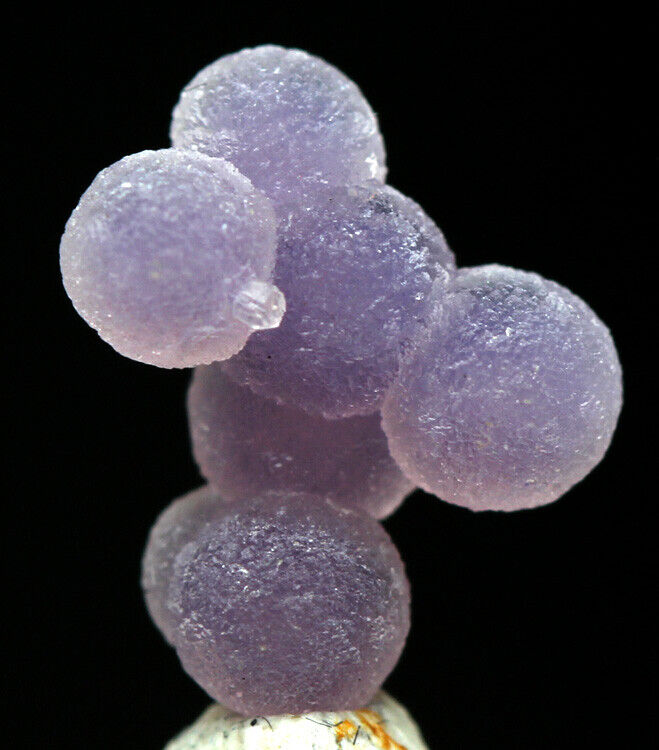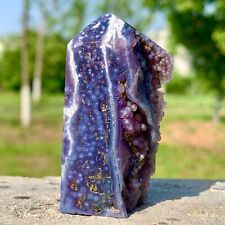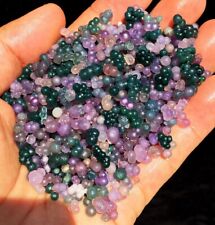When you click on links to various merchants on this site and make a purchase, this can result in this site earning a commission. Affiliate programs and affiliations include, but are not limited to, the eBay Partner Network.
This listing is for a really fascinating grape agate specimen in a display jar,
including an info card about this mineral and the location this specimen came from.
This kit is great for avid mineral specimen collectors or beginners.
It would be a perfect gift set for getting someone interested in mineral collecting and science.
The 1 centimeter scale cube is for size comparison only. It is not included in the sale.
The photos are of several different specimens, but this listings is for one specimen with an info card.
The photos show multiple specimens to give a representation of the variety of shapes and colors in these specimens.I offer a shipping discount for customers who combine their payments for multiple purchases into one payment!
The discount is regular shipping price for the first item and just 50 cents for each additional item!
To be sure you get your shipping discount just make sure all the items you want to purchase are in your cart.
sales you win are added to your cart automatically.
For any "buy it now" items or second chance offers, be sure to click the "add to cart" button, NOT the "buy it now" button.
Onceall of your items are in your cart just pay for them from your cart andthe combined shipping discount should be applied automatically.I offer a money back guarantee on every item I sell.
If you are not 100% happy with your purchase just send me a message to let me know
and I will buy back the item for your full purchase price.Hi there. I am selling this beautiful, purple, grape agate chalcedony specimen. These lovely specimens come from the island of Sulawesi, Indonesia! They are totally and completely fascinating and I loved them from the moment I first saw them. If you have any questions, do not hesitate to ask me. Thanks so much for visiting my listing and have a great day! From Wikipedia, the free Oxide minerals, quartz groupFormula(repeating unit) Silica (silicon dioxide, SiO2)Crystal system Trigonal or monoclinicIdentificationFormula mass 60 g/molColor VariousCleavage AbsentFracture Uneven, splintery, conchoidalMohs scale hardness 6 - 7Luster Waxy, vitreous, dull, greasy, silkyStreak WhiteDiaphaneity TranslucentSpecific gravity 2.59 - 2.61References [1]Chalcedony ( /kælˈsɛdəni/) is a cryptocrystalline form of silica, composed of very fine intergrowths of quartz and moganite.[2] These are both silica minerals, but they differ in that quartz has a trigonal crystal structure, while moganite is monoclinic. Chalcedony's standard chemical structure (based on the chemical structure of quartz) is SiO2 (silicon dioxide).
Chalcedony has a waxy luster, and may be semitransparent or translucent. It can assume a wide range of colors, but those most commonly seen are white to gray, grayish-blue or a shade of brown ranging from pale to nearly black. The color of chalcedony sold commercially is often enhanced by dyeing or heating.[3]
The name chalcedony comes from the Latin chalcedonius (alternatively spelled calchedonius). The name appears in Pliny the Elder's Naturalis Historia as a term for a translucid kind of Jaspis.[4] The name is probably derived from the town Chalcedon in Asia Minor.[5] The Greek word khalkedon (χαλκηδών) also appears in the Book of Revelation (Apc 21,19). It is a hapax legomenon found nowhere else, so it is hard to tell whether the precious gem mentioned in the Bible is the same mineral known by this name today.[6]Rare Morroccan pseudomorph of spiral Turritella-like snail has been replaced by chalcedonyContents [hide]1 Varieties1.1 Agate1.2 Aventurine1.3 Carnelian1.4 Chrysoprase1.5 Heliotrope1.6 Moss agate1.7 Mtorolite1.8 Onyx2 History3 Geochemistry3.1 Structure3.2 Solubility3.2.1 Solubility of quartz and chalcedony in pure water4 See also5 References6 External linksVarieties[edit]Chalcedony occurs in a wide range of varieties. Many semi-precious gemstones are in fact forms of chalcedony. The more notable varieties of chalcedony are as follows:
Agate[edit]
AgateAgate is a variety of chalcedony characterized by either transparency or color patterns, such as multi-colored curved or angular banding. Opaque varieties are sometimes referred to as jasper.[3] Fire agate shows iridescent phenomena on a brown background; iris agate shows exceptional iridescence when light (especially pinpointed light) is shone through the stone. Landscape agate is chalcedony with a number of different mineral impurities making the stone resemble (Unknown scale)Aventurine is a form of quartz, characterised by its translucency and the presence of platy mineral inclusions that give a shimmering or glistening effect termed aventurescence. Chrome-bearing fuchsite (a variety of muscovite mica) is the classic inclusion, and gives a silvery green or blue sheen. Oranges and browns are attributed to hematite or (also spelled cornelian) is a clear-to-translucent reddish-brown variety of chalcedony. Its hue may vary from a pale orange, to an intense almost-black coloration. Similar to carnelian is sard, which is brown rather than (also spelled chrysophrase) is a green variety of chalcedony, which has been colored by nickel oxide. (The darker varieties of chrysoprase are also referred to as prase. However, the term prase is also used to describe green quartz, and to a certain extent is a color-descriptor, rather than a rigorously defined mineral variety.)
Blue-colored chalcedony is sometimes referred to as "blue chrysoprase" if the color is sufficiently rich, though it derives its color from the presence of copper and is largely unrelated to nickel-bearing or bloodstoneHeliotrope is a green variety of chalcedony, containing red inclusions of iron oxide that resemble drops of blood, giving heliotrope its alternative name of bloodstone. In a similar variety, the spots are yellow instead, known as plasma.
Moss agate[edit]
Tree agateMoss agate contains green filament-like inclusions, giving it the superficial appearance of moss or blue cheese. There is also tree agate which is similar to moss agate except it is solid white with green filaments whereas moss agate usually has a transparent background, so the "moss" appears in 3D. It is not a true form of agate, as it lacks agate's defining feature of concentric is a green variety of chalcedony, which has been colored by chromium. Also known as chrome chalcedony, it is principally found in Zimbabwe.
Onyx[edit]
OnyxOnyx is a variant of agate with black and white banding. Similarly, agate with brown, orange, red and white banding is known as cameo of Titus head, 2nd Century ADAs early as the Bronze Age chalcedony was in use in the Mediterranean region; for example, on Minoan Crete at the Palace of Knossos, chalcedony seals have been recovered dating to circa 1800 BC.[8] People living along the Central Asian trade routes used various forms of chalcedony, including carnelian, to carve intaglios, ring bezels (the upper faceted portion of a gem projecting from the ring setting), and beads that show strong Greco-Roman influence.
Fine examples of first century objects made from chalcedony, possibly Kushan, were found in recent years at Tillya-tepe in north-western Afghanistan.[9] Hot wax would not stick to it so it was often used to make seal impressions. The term chalcedony is derived from the name of the ancient Greek town Chalkedon in Asia Minor, in modern English usually spelled Chalcedon, today the Kadıköy district of Istanbul.Chalcedony knife, AD 1000-1200According to tradition, at least three varieties of chalcedony were used in the Jewish High Priest's Breastplate. (Jewish tradition states that Moses' brother Aaron wore the Breastplate, with inscribed gems representing the twelve tribes of Israel). The Breastplate supposedly included jasper, chrysoprase and sardonyx, and there is some debate as to whether other agates were also used.
In the 19th century, Idar-Oberstein, Germany, became the world's largest chalcedony processing center, working mostly on agates. Most of these agates were from Latin America, in particular Brazil. Originally the agate carving industry around Idar and Oberstein was driven by local deposits that were mined in the 15th century.[10] Several factors contributed to the re-emergence of Idar-Oberstein as agate center of the world: ships brought agate nodules back as ballast, thus providing extremely cheap transport. In addition, cheap labor and a superior knowledge of chemistry allowed them to dye the agates in any color with processes that were kept secret. Each mill in Idar Oberstein had four or five grindstones. These were of red sandstone, obtained from Zweibrücken; and two men ordinarily worked together at the same was once thought to be a fibrous variety of cryptocrystalline quartz.[11] More recently however, it has been shown to also contain a monoclinic polymorph of quartz, known as moganite.[2] The fraction, by mass, of moganite within a typical chalcedony sample may vary from less than 5% to over 20%.[12] The existence of moganite was once regarded as dubious, but it is now officially recognised by the International Mineralogical is more soluble than quartz under low-temperature conditions, despite the two minerals being chemically identical. This is thought to be because chalcedony is extremely finely grained (cryptocrystalline), and so has a very high surface area to volume ratio.[citation needed] It has also been suggested that the higher solubility is due to the moganite component.[12]
Solubility of quartz and chalcedony in pure water[edit]This table gives equilibrium concentrations of total dissolved silicon as calculated by PHREEQC (PH REdox EQuilibrium (in C language, USGS)) using the llnl.dat database[citation needed].
Temperature Quartz solubility (mg/L) Chalcedony solubility (mg/L)0.01 °C 0.68 1.3425.0 °C 2.64 4.9250.0 °C 6.95 12.3575.0 °C 14.21 24.23100.0 °C 24.59 40.44







